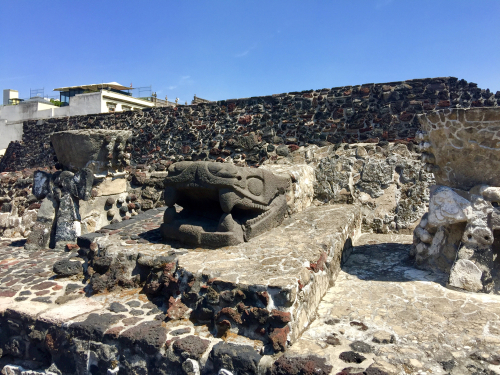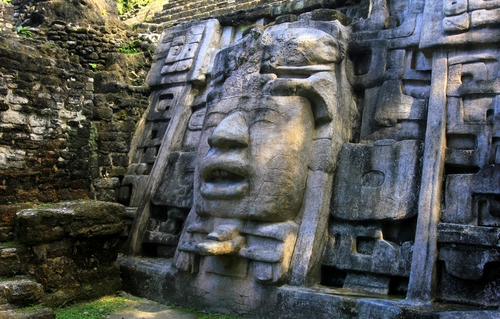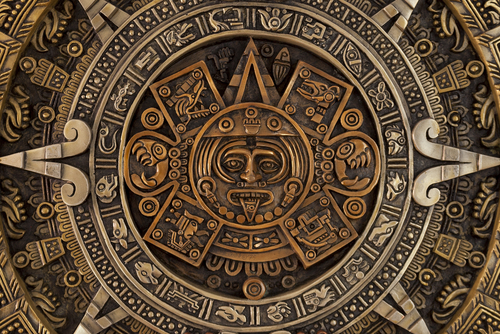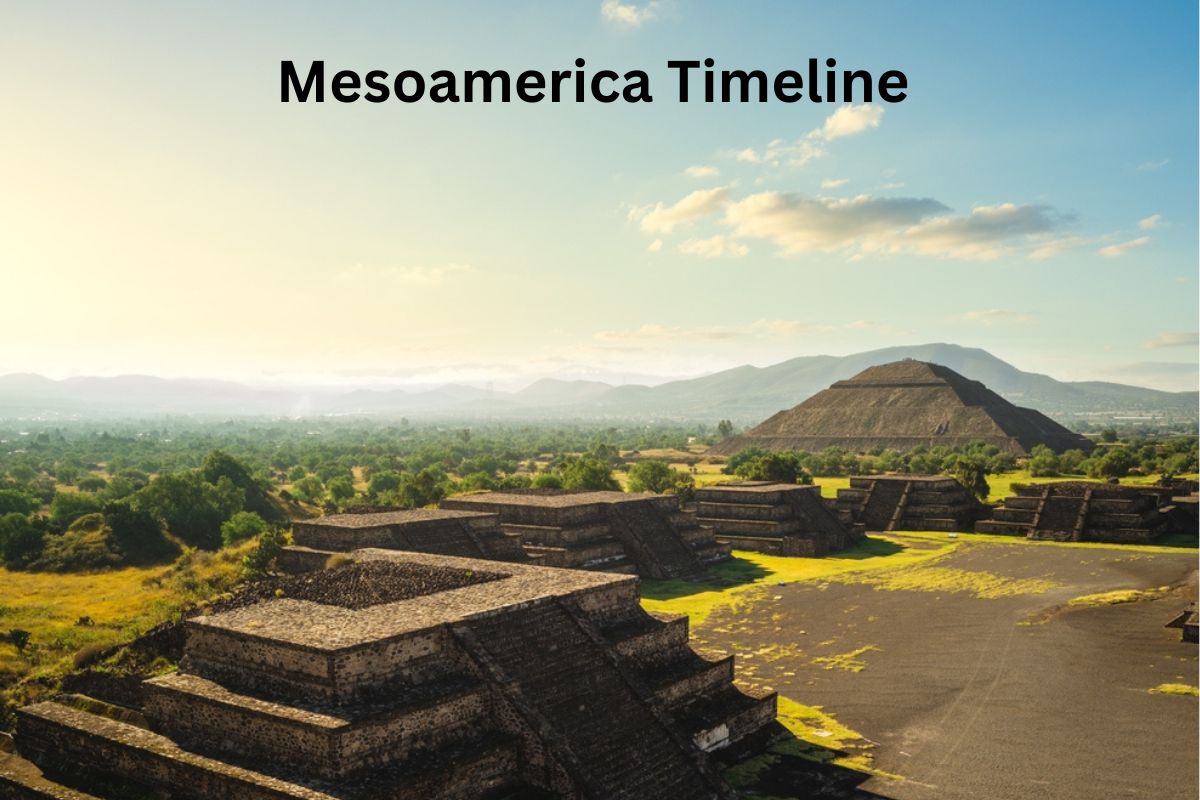Mesoamerica is a historical and cultural region in North America that extends roughly from central Mexico through Belize, Guatemala, El Salvador, Honduras, Nicaragua, and northern Costa Rica.
This area saw the rise and fall of several pre-Columbian civilizations, from the Olmecs, Maya, and Zapotecs to the Aztecs and many others.
Mesoamerican civilizations were known for their advancements in a variety of areas, including architecture, mathematics, calendar systems, and writing systems.
They built grand cities with monumental structures, developed complex social, political, and economic structures, and created rich cultural and religious traditions.
Despite the diversity among these civilizations, they shared a number of cultural traits such as pyramidal structures, ball games, human sacrifices, and a complex pantheon of gods.
The Mesoamerican timeline spans thousands of years, typically divided into periods: the Preclassic (or Formative), the Classic, and the Postclassic.
Also Read: Facts About Mesoamerica
The Preclassic period saw the rise of the first complex societies in Mesoamerica.
The Classic period witnessed the peak of the Maya civilization and the flourishing city of Teotihuacan.
During the Postclassic period, the Toltec and later the Aztec civilizations emerged as dominant powers. The Aztec Empire was at its zenith when the Spanish arrived in the early 16th century, marking the end of the Mesoamerican era and the beginning of the Colonial period.
| Period | Years | Significant Events |
|---|---|---|
| Pre-Classic Period | 2000 BCE–250 CE | – 2000 BCE: The Olmec civilization begins. – 1400 BCE: Teotihuacan is founded. – 400 BCE–300 CE: Zapotec civilization in the Oaxaca region. |
| Classic Period | 250–900 CE | – 250–600 CE: Teotihuacan reaches its peak. – 250–900 CE: Maya civilization’s Classic Period. – Around 700 CE: Teotihuacan’s decline. – Around 900 CE: Classic Maya collapse. |
| Post-Classic Period | 900–1521 CE | – 900–1200 CE: The Toltec civilization arises. – 1325 CE: The Aztecs establish Tenochtitlan. – 1428 CE: Formation of the Aztec Triple Alliance. – 1519–1521 CE: Spanish conquest of the Aztec Empire. |
Timeline of Mesoamerica
Start of Olmec civilization (2000 BCE)
The Olmec civilization is often considered the first major civilization in Mexico.
Located in the tropical lowlands of south-central Mexico, in the present-day states of Veracruz and Tabasco, it rose to prominence around 1400 BCE, but its roots can be traced back to cultures that existed in the region as far back as 2000 BCE.
Also Read: Olmec Facts
The Olmec are renowned for their monumental stone heads, and they had significant influence on later Mesoamerican cultures in terms of art, architecture, and religious practices.

Founding of Teotihuacan (1400 BCE)
The city of Teotihuacan was founded around 1400 BCE. Located in the Basin of Mexico, it grew to be one of the largest cities in the pre-Columbian Americas, with a population at its peak estimated at 100,000 to 200,000.
The city was characterized by its distinctive architectural style, featuring wide avenues and massive pyramids, such as the Pyramid of the Sun and the Pyramid of the Moon.
Teotihuacan was an important cultural and trade center and its influence can be seen in numerous archaeological sites throughout Mesoamerica.
Rise of the Zapotec civilization in Oaxaca (400 BCE–300 CE)
The Zapotec civilization arose in the Oaxaca Valley, where they constructed the city of Monte Albán, one of the first urban centers in Mesoamerica.
The Zapotec developed an intricate social and political structure, with a writing system and calendar system, and they had significant advances in architecture and urban planning.
The civilization had extensive trade networks and produced a distinctive style of art, including finely crafted gold and silver jewelry and intricately designed ceramics.
Peak of Teotihuacan (250–600 CE)
During this period, Teotihuacan was one of the largest cities in the world, with a diverse population and complex social structure.
The city had massive multi-family residential complexes, a grid pattern of roads and streets, and numerous pyramids, including the Pyramid of the Sun and the Pyramid of the Moon.
The city was a significant center of trade and production, particularly for obsidian, a volcanic glass used for making tools and decorative items.

Classic Period of the Maya civilization (250–900 CE)
This era is often considered the peak of the Maya civilization. It was characterized by the construction of numerous monumental structures, advances in science, astronomy, and mathematics, and the development of a complex writing system.
During this period, the Maya civilization was composed of numerous city-states, each with their own king, but they were linked by complex systems of alliances and enmities. Key city-states included Tikal, Palenque, and Copán.
Decline of Teotihuacan (Around 700 CE)
The decline of Teotihuacan is believed to have started around the end of the 6th century, reaching its climax around 700 CE.
The reasons behind its decline are still debated among scholars, but theories include internal social unrest, economic instability, and invasion by external forces. Evidence shows that many of the city’s structures were burned, suggesting a violent end.
Classic Maya collapse (Around 900 CE)
This refers to the abandonment of many of the lowland Maya cities and a general socio-political collapse in the southern Maya lowlands.
Scholars continue to debate the causes of this collapse, but possibilities include overpopulation, environmental degradation, warfare, disease, and climate change.
While the southern cities declined, the northern cities, especially those on the Yucatán Peninsula, like Chichen Itza and Uxmal, continued to thrive until the Spanish conquest.
Rise of the Toltec civilization (900–1200 CE)
After the fall of Teotihuacan, the Toltec civilization emerged as a dominant regional power in central Mexico. The Toltecs established their capital at Tula (now in Hidalgo, Mexico) and their culture had significant influences on later Mesoamerican civilizations, notably the Aztecs.
The Toltecs were skilled warriors and are particularly known for their architectural style, as evident in the temple complexes decorated with large columns shaped like warriors.

Establishment of Tenochtitlan by the Aztecs (1325 CE)
The Aztecs, also known as the Mexica, founded their capital city of Tenochtitlan in 1325 on an island in Lake Texcoco, in the Valley of Mexico.
Over time, it grew to be one of the largest cities in the world, with complex social, political, and economic structures.
The city was characterized by its remarkable urban planning and impressive architectural structures, such as the Templo Mayor.
Formation of the Aztec Triple Alliance (1428 CE)
The Aztec Empire was formed by a triple alliance between the cities of Tenochtitlan, Texcoco, and Tlacopan. This marked the start of the Aztec’s dominance in central Mexico.
The alliance helped them to secure trade routes and expand their territory, eventually making the Aztecs the most powerful civilization in Mesoamerica by the time the Spanish arrived.
Spanish conquest of the Aztec Empire (1519–1521 CE)
Led by Hernán Cortés, the Spanish started their campaign to conquer the Aztec Empire in 1519.
Despite facing significant resistance, the Spanish, allied with many of the Aztec’s local enemies and aided by the spread of diseases like smallpox, managed to capture the capital, Tenochtitlan, in 1521, marking the fall of the Aztec Empire.
This event signaled the end of the pre-Columbian era in Mesoamerica and began the period of Spanish colonial rule.
